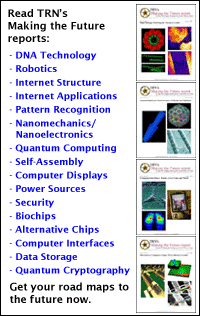
Net scan finds like-minded users
By
Kimberly Patch,
Technology Research NewsWhen you search for information on the Web, chances are you aren't alone -- there are like-minded groups of users across the Web searching for the same sorts of things.
Researchers from the University of Chicago have shown that is possible to identify these groups by analyzing browsing patterns, even in networks as far-flung as the Web.
The researchers' method of graphing information across data distribution systems like the Internet shows that, given a large enough sample, computer users can be grouped according to their common interests based only on their requests for data. "One of the first questions we asked was is the group-based collaboration of scientists mirrored somehow in their usage of data," said Adriana Iamnitchi, a researcher at the University of Chicago.
The answer turned out to be yes, across all types of group-based interests. "Communities as heterogeneous as the Web seem to show this pattern of having users naturally group in interest-based groups," she said.
The information-request graphing method can be used to design scalable, adaptive methods for locating and delivering data, said Iamnitchi. The method could theoretically be used by anyone, including ecommerce vendors, to target communities of interest.
The researchers are working on using the patterns to design more efficient services for resource-sharing environments like Grid computing, Iamnitchi said.
Grid software coordinates a few or even hundreds of computers across networks like the Internet to piece together compute power and resources like databases into powerful virtual computers; the combined resources can speed up scientific and engineering applications like time-consuming equations and three-dimensional simulations.
The researchers found the data-sharing relationship pattern while looking for a way to leverage characteristics of the Grid computing community to make that type of computing more efficient, according to Iamnitchi. "Our idea was to... design mechanisms [that are] able to cope efficiently with large and dynamic numbers of resources -- data files, computers, and storage space for results," she said.
One typical characteristic of the community that uses Grid computing is they tend to collaborate, said Iamnitchi. When the researchers analyzed traces of scientific computations from a high-energy physics collaboration that spanned 18 countries and involved 70-odd institutions and thousands of physicists, they found that the patterns of collaboration were mirrored in scientists' data requests.
The researchers looked at the relationships that formed among users based on the data they were interested in. "We captured and quantified these relationships by modeling the system as a data-sharing ... graph whose nodes are the data consumers in that system," said Iamnitchi. Nodes, or people, who requested a given number of the same files within a given time were connected.
In an analysis of six months worth of scientists' requests for data, the researchers found that group-based collaboration is visible in the way information is requested, said Iamnitchi. "Scientists form groups of interest based on the data they used," she said. The researchers found the same pattern in a larger analysis of general Web requests.
The pattern of similar requests shared the small-world characteristic common in many networks, including the way data is arranged in networks like the Internet.
In small-world networks, it is possible to get from one node to any other node by traversing relatively few links. Social networks, with people as nodes and relationships as links, and the Web, with pages as nodes, and links between pages as links, are also small-world networks.
Looking at small-world topologies is not a novel idea, but the method of extracting a graph from an arbitrary data-sharing relationship and using it to study these structures is, said Filippo Menczer, an assistant professor of management services at the University of Iowa.
Data request patterns have been analyzed previously, but in different ways -- to examine the popularity distribution of Web requests or to study the most efficient way to cache Internet traffic. In contrast, the Chicago researchers' analysis uncovered relationships between users based on their common interests in data.
The method is potentially useful, especially because a graph can be made from any Web usage log, said Menczer. "Any Webmaster can do this."
The method may be useful for discovering clusters of users who have interest in a certain type of data, Menczer said. "Ecommerce vendors are currently using collaborative filtering techniques, which are related to this," to do so, he said. The method can also be used for distributed caching and broadcasting, similar to the services offered by Akamai Technologies Inc., he said.
The researchers are now making the method more efficient for resource-sharing environments like Grid computing, said Iamnitchi. "We are currently looking... to design mechanisms to locate resources," she said. "The ultimate goal is to provide scalable, adaptive mechanisms [that are] able to deal with variations in resource participation."
The resource location mechanisms could be ready to use within two years, Iamnitchi said.
Iamnitchi's research colleagues were Matei Ripeanu from the University of Chicago and Ian Foster from Argonne National laboratory. The research was funded by the National Science Foundation (NSF).
Timeline: 2 years
Funding: Government
TRN Categories: Internet; Distributed Computing
Story Type: News
Related Elements: Technical paper, "Data-Sharing Relationships in the Web," posted on the arXiv physics archive at arXiv.org/abs/cs.NI/0302016.
Advertisements:
May 7/14, 2003
Page One
Screen arcs widen view
Light show makes 3D camera
Net scan finds like-minded users
Sound forms virtual test tubes
News briefs:
Nanotube shines telecom light
Touchy-feely goes remote
Light mix makes strong metal
Metal expands electrically
Researchers fill virus with metal
Gold connectors stretch
News:
Research News Roundup
Research Watch blog
Features:
View from the High Ground Q&A
How It Works
RSS Feeds:
News
Ad links:
Buy an ad link
| Advertisements:
|
 |
Ad links: Clear History
Buy an ad link
|
TRN
Newswire and Headline Feeds for Web sites
|
© Copyright Technology Research News, LLC 2000-2006. All rights reserved.